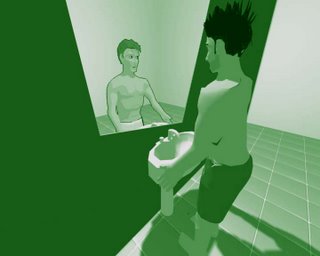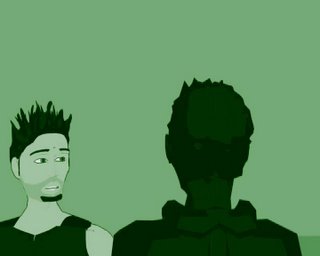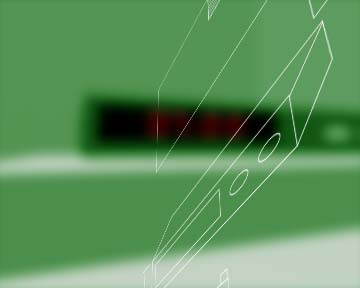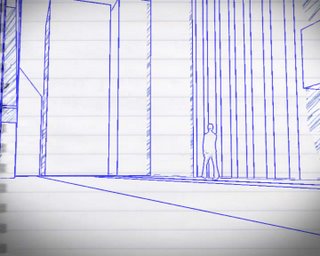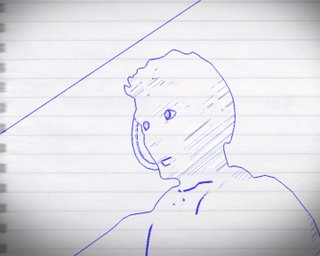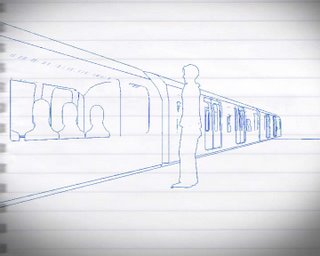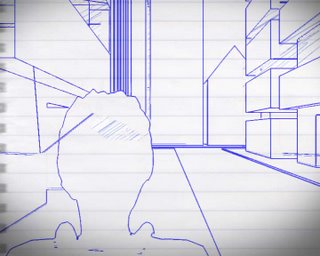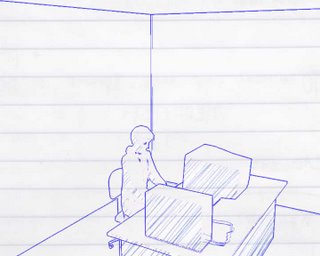ARTIST STATEMENT:The author since childhood liked to draw and expressing his feeling in drawings. The author did not want to loose his attachment towards art and creativity. This led him to take this field as profession.
Being brought up in Athens he was exposed to art right from the start. He has been studying different mediums. All mediums have there own specialists. Having expressed himself in different mediums he was always interested in 3D design and animation. It was a comparatively new medium for him.
The author makes art as a medium of communication. To him art captures a moment, a thought, a feeling, and an experience and it is then shared with another person or persons. The ways these experiences are expressed are totally up to the artist. Some want to express straight some want the audience to think what is being said. For the purpose of expression one need to be an expert, to be comfortable in the medium being used.
The author picked the current techniques like 3d animation and toon rendering e.g. in the works of Disney and Synthetique and implement them in his work with directing ideas from filmmakers like Robert Wiene, Dziga Vertov, Sergei M. Eisenstein, Tim Burton.
This project was completed by the author with the use of 3D characters which were developed, animated and rendered in 3D Studio max. The character animation was rendered with Toon rendering technique. The renderings have been edited and enriched with graphic in after effects.
The author thinks that art means to him as a blue print of his experience and ideas frozen in time in form of his art piece.
REFLECTION:Critical analysis of out comes compared with intentions
For this purpose the author sent emails of the progress on the work done in different stages of the project to the tutors. Asking for their feed back and making necessary changes where ever it was found
Initially the author made the stories based the concept of alter ego. Where as the research that was intended to be done was technical in nature and based on combing different skills and techiniques. Later the author changed the research topic to get insight in the factor of “alter ego” of an art piece. Thus the movie as an art piece was remade reflecting an alter ego of itself. The concept of the stories remained the same.
There were three main objectives that were intended by the author initially.
The first was usage of different treatment to enrich and furbish the graphical portrayal of the subject. This was achieved by using extra layers during editing. The author made extra scences and then picked the best shots to get best possible results.
The second objective was to explore the combination of 2D layers, Alpha Channels and 3D animation. These outcomes can be seen in the short movie where the author has used all rendered the scenes from 3D software (3D studio Max) and added the layers and the alpha channels in editing software (After effects).
To make two synchronized films and observe the viewers attention by recording their reaction was the third objective of the project. This goal was dropped during the execution of the project with the consent of the tutors. It was not possible for the author to work academically on the project to evaluate his work and make changes to the final product. Therefore the author focused on other goals.
To conduct research in the area of direction. The author conducted research by using internet and books. Please refer to the references to this research were submitted in the previous report.
The author with the help of this project improved his ability to express new artistic language. This was one of the main goals of this project.
A review of over all progress
The author thinks that he had more opportunity to explore in artistic experimentation and research as a student of the University than in his profession.
At the start of the course the author was thinking of the project from the learning perspective in the fields of the 3D design skills and techniques. Later this perspective was changed to put more emphasis on the concept of the movie and the progress. This was done after having feed back from the teacher.
From the point that the author started his project to point when the author is putting the finishing touches to the project, he has learnt knowledge of using techniques and skills and their respective background. These techniques and skills were achieved by thorough research and putting into practice the new skills learnt.
The author used differnet rendefing techniques. The first technique that was used was full toon rendering with flat colours. The character of the movie looked too stiff, and the animation genarally too 'clear' and predictable, so the mood changed to darker with only some spotlights in the scene. This experiment was black and white animation in order to add even darker touch. The author finalized in the hand drawn ink-pen style of treatment which gives more artistic and minimal look.
The installation for visual display would be made different than the traditional display. There would be two screens projecting both the movies simultaneosly on different screens. The sound is used as a link of the two movies.
Critical Analysis
Although the project is up to author’s expectation but there was always room for improvement. This could have been achieved by having a team based project.
The entire project was learning experience for the author. The author learnt new skills in 3D modelling and animation. Time management skills became better. Research was another important aspect of this project and based on research the author improved and learned new methods in the area of 3D modelling. This was all possible due to an active interest and dedication of the author. The author had a keen interest to learn new techniques that would help him overcome the difficulties that would arise in different phases of the project.
Some of the main difficulties the author faced were to learn in a very short time span 3D character modelling. Some ideas were changed or dropped after getting negative feedback from teacher and audience. There were strict dead lines to meet and this obstacle was met by efficient time management although some scene in the author perspective could be improved by introducing additional effects.
Strengths of the work done for the Project
The author likes the originality of his idea of the contrast between the two different treatments in one project, even though they are both made in 3D design software. The first have traditional touch i.e. ink pen drawn effect and the other a digital modern look.
All characters used in though out the project were developed by the author. No ready made 3D models were used.
Another unique idea of applied and experimented is two animations made on the same audio track. This was a challenge that would help the author to enhance his synchronization skills.
The author thinks that the camera angles and the blur effects used in the project are strength of the project.
The Digital effects which are used as impressionistic communication with audience in the second video were achieved by using alpha channels. The refraction and glow on the surfaces was another positive aspect of the project.
The author put extra work to achieve better results. Extra scences were made and then picked the best shots to achieve good camera angles. Also for the creation of the first movie three different styles were used. These styles were evaluated by panel of expert (university tutors). After feed back from the experts a final selection was made.
Almost all the scenes have their own background environments.
Weakness of the work done in the Project
The project undertaken by the author was an academic exercise. The author had some time and budget constraints, due to which the author thinks there were some short comings in the project. Some of the main weaknesses are as following.
The animation of the walking scenes could be improved by adding more realistic floating animation. Apart from the floating animation there were some limited movements of the character while walking or repetition in animation. This could be improved by the author if it was not for the time constraints due to academic reasons.
The author needs to learn and investigate more about the face controllers in character animation. This would help him make better facial expression and improve on lip sinking.
In conclusion the author has decided to upgrade his hardware used so that a better proficiency can be obtained in making heavy effects and time can be saved in rendering the files. As the author is new to 3D character animation he has decided to do further research in the area to achieve advance skills.
Lessons learnt
Following were the main lessons learnt by the author during this project:
• The author learnt how to create Blogs this would help the author to be more organized be in touch with other artists working in the same sector.
• The author improved on the animation techniques and timing.
• The author learnt the use of “Depth of the field” of a camera to produce blur effect in the 3D environment. This gives much more realistic when rendered.
• The author learnt how to use Harvard referencing. This would help him in perusing the PHD.
• Some new “Texturing techniques” were used in the project. For example Toon rendering was learnt during the execution of this project.
• The author experimented with new artistic expression in allegoric, minimal and symbolic techniques.
• Attaching objects to characters was learnt.
• Improved use of alpha channels both in editing and 3D software.
• The author gained the knowledge of basic floating of the animations but there room for improvement.
• Practical skills in management of projects and experience and ability to fulfil the needs of a client were also a very important aspect of the project that was improved during this project.
Plan for further development
The author of this document plans to do further research and enhance his skills in 3D animation. Some of the areas that he would like to focus on are facial expression animation and floating animation. Another thing the author would like to learn is how to plan a low polygon modeling. This is very important in video games projects where there is a limitation on the polygons. Which is directly involved with bit budgeting.
The author intends to use the expertise used in this degree in the field of advertising. It would help to made 3D video games, video editing and film making.
Apart from the working in the industry the author would like to work on independent films production and make short movies as leisure pursuits.
Further more the author wants to research the history of 3D modeling and dominant influences of different cultural production on 3D animation. The author has applied for PHD on this topic to be specific the research topic would be
“How the Japanese animation has influenced the character modeling of the West? And why eastern European animation which also evolved into a strong industry has not made a significant mark in the West?”
BIBLIOGRAPHYArnheim, R. (1969), Visual Thinking, Berkeley: University of California Press.
Ceram, C.W. (1965) The Archaeology of the Cinema, New York: Harcourt, Brace and World.
Friends of the National Film Archive. (1963), A season of the films of Sergei Eisestein : 1st October 1963-13th October1963, London, National Film Theatre
Hallas J. (1987), Masters of animation, London: BBC books.
Lucie-Smith, Edward. (1975), Movements in Art since 1945, London, Thames and Hudson
Nash, John Malcolm. (1974),Cubism, futurism and constructivism, London, Thames and Hudson
Roberts, Graham. (2000), The man with the movie camera, London, I.B. Tauris
Scenkel T. (1977), Exploring the cinema of figurative animation, PhD dissertation, New York University.
World Wide Web:
www.pixar.com
www.wikipedia.com
http://news.bbc.co.uk
http://www.pbs.org
http://www.ejumpcut.org/
http://blackboard.arts.ac.uk/
Science Museum in U. K. London
http://www.pixar.com/featurefilms/ts/
Van Eaton Galleries, A Brief Biography of McCay Winsor
http://www.vegalleries.com/winsorbio.html
